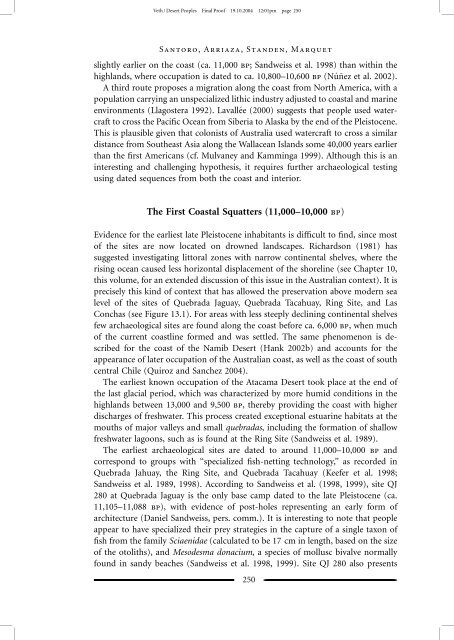You also want an ePaper? Increase the reach of your titles
YUMPU automatically turns print PDFs into web optimized ePapers that Google loves.
Veth / <strong>Desert</strong> <strong>People</strong>s Final Pro<strong>of</strong> 19.10.2004 12:01pm page 250Santoro,Arriaza,Standen,Marquetslightly earlier on <strong>the</strong> coast (ca. 11,000 bp; Sandweiss et al. 1998) than within <strong>the</strong>highlands, where occupation is dated to ca. 10,800–10,600 bp (Núñez et al. 2002).A third route proposes a migration along <strong>the</strong> coast from North America, with apopulation carrying an unspecialized lithic industry adjusted to coastal and marineenvironments (Llagostera 1992). Lavallée (2000) suggests that people used watercraftto cross <strong>the</strong> Pacific Ocean from Siberia to Alaska by <strong>the</strong> end <strong>of</strong> <strong>the</strong> Pleistocene.This is plausible given that colonists <strong>of</strong> Australia used watercraft to cross a similardistance from Sou<strong>the</strong>ast Asia along <strong>the</strong> Wallacean Islands some 40,000 years earlierthan <strong>the</strong> first Americans (cf. Mulvaney and Kamminga 1999). Although this is aninteresting and challenging hypo<strong>the</strong>sis, it requires fur<strong>the</strong>r archaeological testingusing dated sequences from both <strong>the</strong> coast and interior.The First <strong>Coastal</strong> Squatters (11,000–10,000 bp)Evidence for <strong>the</strong> earliest late Pleistocene inhabitants is difficult to find, since most<strong>of</strong> <strong>the</strong> sites are now located on drowned landscapes. Richardson (1981) hassuggested investigating littoral zones with narrow continental shelves, where <strong>the</strong>rising ocean caused less horizontal displacement <strong>of</strong> <strong>the</strong> shoreline (see Chapter 10,this volume, for an extended discussion <strong>of</strong> this issue in <strong>the</strong> Australian context). It isprecisely this kind <strong>of</strong> context that has allowed <strong>the</strong> preservation above modern sealevel <strong>of</strong> <strong>the</strong> sites <strong>of</strong> Quebrada Jaguay, Quebrada Tacahuay, Ring Site, and LasConchas (see Figure 13.1). For areas with less steeply declining continental shelvesfew archaeological sites are found along <strong>the</strong> coast before ca. 6,000 bp, when much<strong>of</strong> <strong>the</strong> current coastline formed and was settled. The same phenomenon is describedfor <strong>the</strong> coast <strong>of</strong> <strong>the</strong> Namib <strong>Desert</strong> (Hank 2002b) and accounts for <strong>the</strong>appearance <strong>of</strong> later occupation <strong>of</strong> <strong>the</strong> Australian coast, as well as <strong>the</strong> coast <strong>of</strong> southcentral Chile (Quiroz and Sanchez 2004).The earliest known occupation <strong>of</strong> <strong>the</strong> <strong>Atacama</strong> <strong>Desert</strong> took place at <strong>the</strong> end <strong>of</strong><strong>the</strong> last glacial period, which was characterized by more humid conditions in <strong>the</strong>highlands between 13,000 and 9,500 bp, <strong>the</strong>reby providing <strong>the</strong> coast with higherdischarges <strong>of</strong> freshwater. This process created exceptional estuarine habitats at <strong>the</strong>mouths <strong>of</strong> major valleys and small quebradas, including <strong>the</strong> formation <strong>of</strong> shallowfreshwater lagoons, such as is found at <strong>the</strong> Ring Site (Sandweiss et al. 1989).The earliest archaeological sites are dated to around 11,000–10,000 bp andcorrespond to groups with ‘‘specialized fish-netting technology,’’ as recorded inQuebrada Jahuay, <strong>the</strong> Ring Site, and Quebrada Tacahuay (Keefer et al. 1998;Sandweiss et al. 1989, 1998). According to Sandweiss et al. (1998, 1999), site QJ280 at Quebrada Jaguay is <strong>the</strong> only base camp dated to <strong>the</strong> late Pleistocene (ca.11,105–11,088 bp), with evidence <strong>of</strong> post-holes representing an early form <strong>of</strong>architecture (Daniel Sandweiss, pers. comm.). It is interesting to note that peopleappear to have specialized <strong>the</strong>ir prey strategies in <strong>the</strong> capture <strong>of</strong> a single taxon <strong>of</strong>fish from <strong>the</strong> family Sciaenidae (calculated to be 17 cm in length, based on <strong>the</strong> size<strong>of</strong> <strong>the</strong> otoliths), and Mesodesma donacium, a species <strong>of</strong> mollusc bivalve normallyfound in sandy beaches (Sandweiss et al. 1998, 1999). Site QJ 280 also presents_ 250_
















